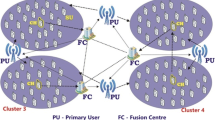Abstract
This paper investigates the problem of Cognitive Radio Network (CRN) with Cooperative Spectrum Sensing (CSS), when multiple idle channels are available. In this work CRN-CSS is modeled to resolve the problems of sensing, grouping and decision making. To enlarge network connectivity and provide larger coverage for users, we integrate CRN-CSS with 5G. Trinary partitioning is performed to group user and perform sensing in cooperative manner. Sensing of multiple channels leads to interference that is overwhelmed by the novel Dynamic Multi-Channel Slot Allocation (DMCSA) algorithm which allocates channel effectively. To address the challenges of spectrum decision, we have presented a special entity (i.e.) Spectrum Agent which is deployed to perform only spectrum sensing and report to fusion center. Fusion center is responsible for decision making and spectrum allocation, for global decision fusion center constructs a graph based on the reports obtained from secondary users and spectrum agent. These reports are compared for making final decision about spectrum. On the whole we describe with a detailed architecture of the proposed CRN-CSS model with seamless integration of 5G cellular networks that achieves higher throughput efficiencies. The obtained simulation results demonstrate the proposed CRN-CSS model with 5G is a remarkable cellular network design to improve throughput, detection probability, delay and sensing overhead.












Similar content being viewed by others
References
Ali A, Hamouda W (2017) Advances on spectrum sensing for cognitive radio networks: theory and applications. IEEE Communications Surveys & Tutorials PP(99):1–29
Umara R, Sheikh AUH (2012) A comparative study of spectrum awareness techniques for cognitive radio oriented wireless networks. Physical communication, vol. 9. Elsevier, pp. 1–23
Liu X, Zhong WZ, Chen KQ (2015) Optimization of sensing time and cooperative user allocation for OR-rule cooperative spectrum sensing in cognitive radio network. J Cent South Univ, Springer 22(7):2646–2654
Jaglan RR, Mustafa R, Sarowa S, Agrawal S (2016) Performance evaluation of energy detection based cooperative sensing in cognitive radio network. Proceedings of First International Conference on Information and Communication Technology for Intelligent Systems, Springer 2:585–593
Xin L, Chen KQ, Yan JH (2016) A novel weighed cooperative bandwidth spectrum sensing for spectrum occupancy of cognitive radio network. J Cent South Univ, Springer 23(7):1709–1718
Bhowmick A, Yadav K, Roy SD, Kundu S (2017) Multi slot-throughput tradeoff in an improved energy detector based faded cognitive radio network. Wireless Networks, Springer, pp. 1–14
Liu X, Jia M, Tan X (2013) Threshold optimization of cooperative spectrum sensing in cognitive radio networks. Radio Sci 48(1):23–32
Althunibat S, Granelli F (2016) On Results’ Reporting of Cooperative Spectrum Sensing in Cognitive Radio Networks. Telecommun Syst, Springer 62(3):569–580
Gaurav V, Sahu OP (2017) Interference Aware Sensing Scheme in Cognitive Radio System. Wireless Personal Communications, Springer 94(3):1405–1425
Jiao Y, Yin P, Joe I (2016) Clustering scheme for cooperative spectrum sensing in cognitive radio networks. IET Commun, IEEE 10(13):1590–1595
So J, Sung W (2016) Group-based Multi-bit Cooperative Spectrum Sensing for Cognitive Radio Networks. IEEE Trans Veh Technol 65(12):10193–10198
Wang Y, Lin W, Huang Y, Ni W (2014) Optimization of Cluster-Based Cooperative Spectrum Sensing Scheme in Cognitive Radio Networks with Soft Data Fusion. Wirel Pers Commun, Springer 77(4):2871–2888
Sharma P, Abrol V (2013) Optimized cluster head selection & rotation for cooperative spectrum sensing in cognitive radio networks. In: Tenth International Conference on Wireless and Optical Communications Networks, IEEE, pp. 1–5
Khalid L, Anpalagan A (2016) Adaptive Assignment of Heterogeneous Users for Group-Based Cooperative Spectrum Sensing. IEEE Trans Wirel Commun 15(1):232–246
Song LL, Liu Y, Wang Z, Zhang SB (2014) Cooperative spectrum sensing based on node recognition in cognitive radio networks. International Conference on Information and Communications Technologies, IEEE, pp. 1–6
Bhowmick A, Nallagonda S, Roy SD, Kundu S (2015) Cooperative Spectrum Sensing with Double Threshold and Censoring in Rayleigh Faded Cognitive Radio Network. Wirel Pers Commun, Springer 84(1):251–271
Verma P, Singh B (2016) On the decision fusion for cooperative spectrum sensing in cognitive radio networks. Wireless Networks, Springer, pp. 1–10
Singh JSP, Rai MK (2017) Cognitive radio intelligent-MAC (CR-i-MAC): channel-diverse contention free approach for spectrum management. Telecommun Syst, Springer 64(3):495–508
Song F, Kan C, Wu Q, Ding G (2015) Optimal Cooperative Spectrum Sensing in Interference-Aware Cognitive Radio Networks. Wirel Pers Commun, Springer 82(4):2171–2184
Li H, Xing X, Zhu J, Cheng X, Li K, Bie R, Jing T (2017) Utility-Based Cooperative Spectrum Sensing Scheduling in Cognitive Radio Networks. IEEE Trans Veh Technol 66(1):645–655
Liao Y, Wang T, Song L, Zhu H (2017) Listen-and-Talk: Protocol Design and Analysis for Full-duplex Cognitive Radio Networks. IEEE Trans Veh Technol 66(1):656–667
Dai J, Wang S (2017) Clustering-Based Spectrum Sharing Strategy for Cognitive Radio Networks. IEEE Journal on Selected Areas in Communications 35(1):228–237
Zhang Z, Zhang W, Zeadally S, Wang Y, Liu Y (2015) Cognitive Radio Spectrum Sensing Framework Based on Multi-Agent Architecture for 5G Networks. IEEE Wirel Commun 22(6):34–39
Author information
Authors and Affiliations
Corresponding author
Rights and permissions
About this article
Cite this article
Giri Prasad, R., Venkatesan, P. Group Based Multi-Channel Synchronized Spectrum Sensing in Cognitive Radio Network with 5G. Mobile Netw Appl 24, 327–339 (2019). https://doi.org/10.1007/s11036-018-1045-8
Published:
Issue Date:
DOI: https://doi.org/10.1007/s11036-018-1045-8




